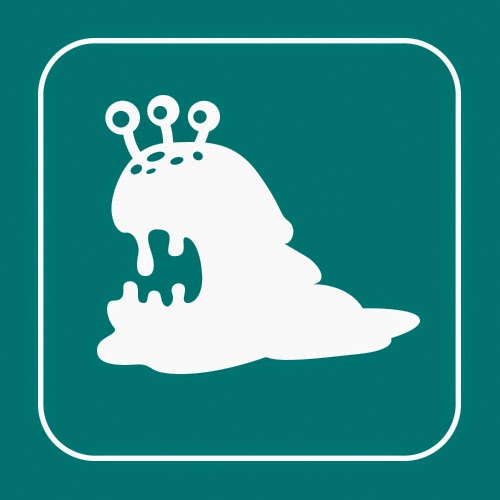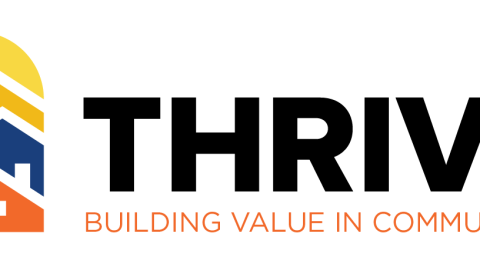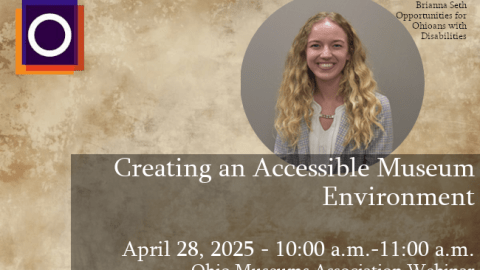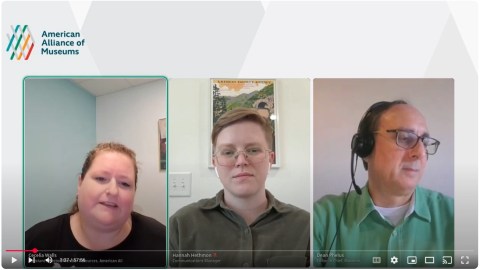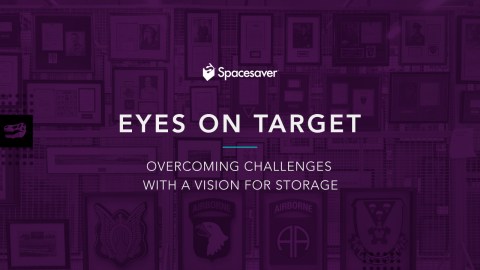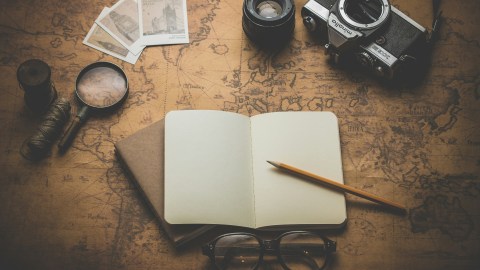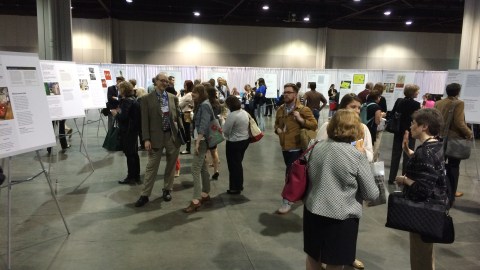
AAM’s annual meeting is a gigantic buffet of content, and I know from experience that navigating the offerings can be somewhat overwhelming. In this post I offer one specialized menu of sessions related to issues I’m watching with a futurist’s eye. Before we dive into that, however, here’s an overview of how you can connect with me at the meeting.
Where to Find the Future (me) at AAM 2025
Tuesday, May 6
1 p.m. – 5 p.m. There are a couple of seats left for my half day workshop on “How to Face the Future, Cultivate Optimism, and Defy Dystopia.” I look forward to an afternoon of building community and bonding over shared hopes and fears. Read about the workshop and how to register in this post.
Wednesday, May 7
From 1:30 p.m. – 2:30 p.m. in Room 502B, I’ll be teaming with my research buddy Susie Wilkening to present the Breaking News from the Annual Survey of Museum-Goers. This is a chance to get a sneak peek at the not-yet-published data on repeat visitation, museums as places of social connection, and community trust and responsibility.
From 2:45 p.m. – 4 p.m. I’ll be staffing the AAM Resource Center in MuseumExpo. If you stop by, I’d love to say hello, chat about your hopes and fears for the future, and hear your thoughts about how I can best support our field and your work, in the coming year.
Thursday, May 8
Thursday is packed with a full slate of CFM offerings.
From 10 a.m. – 11 a.m. Concourse 151 is reserved for my annual TrendsWatch talk. In light of current events, I’m throwing out my existing script to focus on EO Impact and the Next Era of Museum Funding. I’ll offer a futurist’s take on the executive actions rocking our world and the effects they may have on museums’ economic models for years to come. I’m deep into researching how earned, contributed, government, and endowment funding may change in the face of these disruptions, both direct effects (like the current wave of grant and contract cancellations) and indirect effects on critical factors such as travel and tourism, philanthropy, and sponsorships. I hope this talk will help you mentally prepare for what may come, as well as offering some bright spots in an otherwise foreboding forecast.
Immediately following the TrendsWatch talk, from 11 a.m. – 1 p.m. I’ll be hosting discussion tables at the NeighborHubs in Petree Hall for anyone wanting to hash over the talk, the topics in this year’s TrendsWatch report (volunteerism, digital risk, DEI backlash) or to talk about foresight training for our field.
Finally, from 5 p.m. – 6 p.m. I hope you will join me in Room 411 for a special screening of the award-winning documentary Dahomey, which follows the repatriation of 26 royal artifacts from the Musée du Quai Branly to Benin. I wrote a post last month about what to expect from the film.
A Futurist’s Guide to the Program
There are many, many great sessions on the program this year. Having painfully pruned my wish list to a manageable number, here are a few of my top picks for each time slot, related to trends I’m following for the field. (Please note that except for text that appears in quotes, the wording of these session descriptions is my own.)
Wednesday, May 7
8:00 a.m. – 8:25 a.m.
At the Speed of Trust: Programs to Build Trust with and within Communities (Room 405). One of our TrendsWatch topics last year was the loneliness epidemic plaguing the US. This flash session shares programs at two museums that strengthen trust and collaboration which, in turn, can combat loneliness (and tribalism, which is one driver of the partisan divide—another TrendsWatch theme).
8:30 a.m. – 9:30 a.m.
At What Cost? Insights & Challenges in Inclusive Museum Admission (Room 407). I’m always interested in Susie Wilkening’s data-driven insights on museum practice. In this session she partners with Garrett Stone, Director of Research and Development at Thanksgiving Point and Patti Saraniero, Principal of Moxie Research, to present three studies of how income-qualifying access programs can address inclusion, belonging, and trust building.
Voices of America: Expanding Our National Story for the Semiquincentennial (Room 408A). As reporters at Axios recently pointed out, cuts to humanities funding are creating challenges to plans for the Semiquincentennial in 2026. That makes me particularly eager to hear what these presenters (Ann Burroughs, President & CEO, Japanese American National Museum, James Herr, Director, National Center for the Preservation of Democracy, Rick Noguchi, President & CEO, California Humanities, and Danielle Brazell, Executive Director, California Arts Council, have to say about how this commemoration can “go beyond the Founding Fathers to center all the voices and experiences that have shaped the American story, including those of Indigenous peoples and immigrants.”
9:00 a.m. – 9:25 a.m.
PAMMTV: Building Trust One Stream at a Time (Room 410). I’m deeply interested in how museums can create their own social media platforms, independent of the algorithms and income models of commercial platforms. One project I’m following is PAMMTV, Pérez Art Museum Miami’s streaming platform for video art. This flash session will explore how the museum is “creating a trusted digital space that brings world-class media directly into viewers’ homes.”
4:00 p.m. – 5:00 p.m.
Recap: Recovery and Resilience: Cultural Institutions in Response to Environmental Disaster (Room 502B). It is vitally important that our sector prepare for a future shaped by rising climate risk. This session, organized by The J. Paul Getty Trust, will explore how institutions from diverse sectors can “strengthen communities, share knowledge, and collaborate across disciplines, geographies, and time scales to confront ongoing environmental challenges.”
AI in the Archives: How New Technology Can Transform Archival Inquiry (Room 411). Current uses of AI range from frivolous (your avatar in the style of Studio Ghibli!) to essential (radical improvements in medical diagnosis). I’m interested in what museum applications may prove to be critical to mission delivery. In this session staff from the B&O Railroad Museum are going to share how their institution is using AI to analyzing their vast collection of archival records.
Trust and Volunteers: Managing Risk and Reaping Rewards (Room 403B). Jenny Woods, who is past president of American Association for Museum Volunteerism, was one of my advisors for the coverage of volunteerism in this year’s TrendsWatch report. Jenny and her co-presenters from the Lucas Museum of Narrative Art and the Gilb Museum of Arcadia Heritage will “examine how museums can safely trust volunteers to represent the museum, assist with collections care, and fill key roles—as well as how volunteers can trust the museum to train them, keep them safe, and use their time effectively.”
Thursday, May 8
8:30 a.m. – 9:30 a.m.
Meeting in the Middle: Talking Money across Titles (Room 407). Labor practices at museums—including the issues of fair and equitable wages and workplace culture—are an enduring interest of mine. I’d love to hear what these panelists have to so say about “pay equity, precarious work, and how labor practices intersect with DEAI and decolonization.”
Harnessing AI’s Power in Museums: Responsible Innovation to Build Trust (Room 403B). This session promises to explore potential applications of AI to museum operations, as well as ethical frameworks to guide how it is deployed. “Speakers at the intersection of technology and museum ethics will underscore how AI can serve as a tool for transparency, cultural representation, and engagement that aligns with the field’s highest standards.”
1 p.m. – 2 p.m.
Stronger Together: Public-Private Partnership Museum Models (Room 515B). In my TrendsWatch talk on Thursday, I’ll be emphasizing the need for museums to seek out ways to stabilize their income streams. This session explores public-private partnerships, which might be one way to stabilize a museum’s financial base.
Tackling the Truth: Presenting Programs on Difficult Issues (Room 403A). Wow, this is such an important topic right now! How can museums’ “super power of trust” help them engage audiences around challenging topics? “Speakers from the National Museum of African American History and Culture, National Building Museum, and International Spy Museum will discuss how they overcame institutional anxiety to create programs where the public can safely explore timely issues. From national security to climate resiliency and affordable housing, these programs provide honest context for current issues while avoiding virtue signaling.”
Centering Communities, Building Relationships for Indigenous Collections (Room 402AB). My most recent deep dive centers on the next horizon of museum practice with regard to voluntary repatriation, restitution, and reparations. I’d love to hear about the First Americans Museum’s research from “WINIKO: Reunions,” connecting 39 Oklahoma tribal nations with items on loan from the Smithsonian’s National Museum of the American Indian.
2:30 p.m. – 3:30 p.m.
How Can We Democratize Our Museums? Experiences from Europe (Room 407). I was hooked by the opening line of this session’s description: “Trust in democracies is declining.” I’d love to hear what our colleagues from Scotland, Ireland, Wales, and Portugal have to say about “fostering democratic legitimacy within museums,” and their “37 recommendations for incorporating cultural democracy into cultural policies.”
Friday, May 09, 2025
8:30 a.m. – 9:30 a.m.
Activating Museum-Community Partnerships to Advance Health and Well-being (Room 407). How can I resist a session explicitly framed around museums as community infrastructure? (That was the thesis of the 2022 edition of TrendsWatch.) This session promises to explore “how programs focused on inclusive arts experiences can help combat social isolation, enhance communication, and cultivate a deeper sense of belonging.” Particularly interesting as the speakers come to this topic from outside the museum sector: the International Arts + Mind Lab, the Arts & Healing Initiative, the Los Angeles County Department of Arts and Culture, and the Center for Music, Brain and Society at the University of Southern California.
Creative Commons Crash Course: Create and Curate Open Cultural Heritage (Concourse 153ABC). I could use a primer on Creative Commons (CC) legal tools—perhaps you could, too? “This workshop provides a crash course in CC licenses and public domain tools” and promises attendees will “come away with a better understanding of the public domain, open licensing, and copyright considerations with digitization projects.”
10:30 a.m. – 11:30 a.m.
Cultural Property & Trust: Processes at Acquiring & Non-Acquiring Museums (Room 409AB). One of my roles as a museum futurist is to help our field question the assumptions that shape our practice. For example: “museums collect and preserve.” But what if they didn’t? I’d be very interested to hear what staff from the Penn Museum, Museum of Us, Museum of Fine Arts, Boston, Worcester Art Museum, and the Met have to say about how and why their organizations decide what to acquire—or not to acquire at all.
1:30 p.m. – 2:30 p.m.
Fostering Collaboration and Dialogue: The National Conversation on Race LA (Room 402AB). This session tackles yet another critical question: “how can museums foster meaningful conversations on race and racism?” I’d love to hear what staff from the Smithsonian Institution, the Japanese American National Museum, LA Plaza de Cultura y Arte, and the Chinese American Museum have to say on the topic.
1:30 p.m. – 3:00 p.m.
Using Digital Twins and Carbon Calculators to Create Eco-Friendly Exhibitions (Room 502A). If you think that the term “digital twin” merely refers to a digital replica of a physical object (e.g., a digital image of the Mona Lisa), prepare to have your mind blown by this exploration of REAL digital twins: data-driven, interactive models that, combined with carbon calculators, can help track, tweak, and minimize environmental impact. Thank you for offering this session, Leslie (Leslie Tom, Charles H. Wright Museum of African American History), Korzell (Korzell Coe, also from the Wright), and Douglas (Douglas Flandro, CambridgeSeven Associates, Inc.).
2:30 p.m. – 2:55 p.m.
Envisioning the Future: Building Spaces for Creative Aging and Older Adults (Room 410). What would a truly age-friendly museum look like? With nearly a quarter of the US population projected to be 65 or older by 2050, this is a critical question for all of our sector. Kessanda Abel is going to share insights from the Tampa Museum of Art. You might pair this with the following session:
3:30 p.m. – 3:55 p.m.
Creative Aging in Museum Education (Room 405). Lessons from Museum of Contemporary Art San Diego on addressing ageism and serving older adults.
4:30 p.m. – 4:55 p.m.
Safe is Not a Bad Word (Room 405). With so many people—both visitors and staff—feeling unsafe these days, this session’s promise to “look at safety through three lenses—personal, intellectual, and material—and share how institutions are making sure they are safe environments for all” is very timely.
___________________
These selections are only a small fraction of the content on offer in LA—I encourage you to browse the whole program, and share your recommendations in comments, below.
Warmest regards from the future,
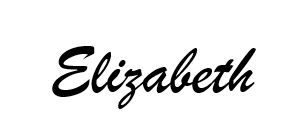
Elizabeth Merritt, Vice President of Strategic Foresight and Founding Director, Center for the Future of Museums, American Alliance of Museums
